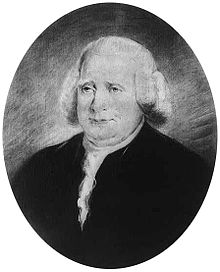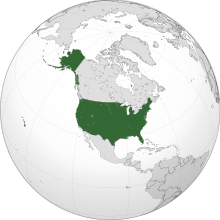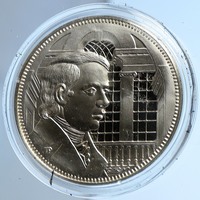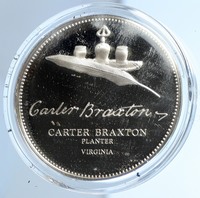United States of America
Bicentennial - Council of the Thirteen Original States - Carter Braxton
1975 Proof Silver Medal 38mm (31.36 grams) Sterling Silver
Reference: Franklin Mint
Carter Braxton facing 4/5 right in government building.
CARTER BRAXTON PLANTER VIRGINIA, Feather pen and ink well, signature below.
Edge Lettering:
OFFICIAL MEDAL OF THE BICENTENNIAL COUNCIL OF THE 13 ORIGINAL STATES 75 P STERLING You are bidding on the exact item pictured, provided with a Certificate of Authenticity and Lifetime Guarantee of Authenticity.
The Thirteen American Colonies formed the United States of America in July 1776. Their groupings were: New England (New Hampshire; Massachusetts; Rhode Island; Connecticut); Middle (New York; New Jersey; Pennsylvania; Delaware); Southern (Maryland; Virginia; North Carolina; South Carolina; and Georgia).
 Carter Braxton (September 10, 1736 – October 10, 1797) was a signer of the United States Declaration of Independence, a merchant, planter, a Founding Father of the United States and a Virginia politician. A grandson of Robert "King" Carter, one of the wealthiest and most powerful landowners and slaveholders in the Old Dominion, Braxton was active in Virginia's legislature for more than 25 years, generally allied with Landon Carter, Benjamin Harrison V, Edmund Pendleton and other conservative planters. Carter Braxton (September 10, 1736 – October 10, 1797) was a signer of the United States Declaration of Independence, a merchant, planter, a Founding Father of the United States and a Virginia politician. A grandson of Robert "King" Carter, one of the wealthiest and most powerful landowners and slaveholders in the Old Dominion, Braxton was active in Virginia's legislature for more than 25 years, generally allied with Landon Carter, Benjamin Harrison V, Edmund Pendleton and other conservative planters.
Carter Braxton purchased a small schooner shortly after his second marriage and turned his energies to trade. Braxton traded between the West Indies and American colonies, establishing relationships with Bayard & Son of New York and Willing & Morris of Philadelphia. He also urged the Brown brothers of Providence, Rhode Island, who had abandoned the slave trade during the French and Indian War, to sell him African people, but such transactions may not have completed. Whether or not Braxton's mercantile enterprises included slave trading, he and his brother were accompanied by a black slave at the College of William & Mary. Braxton later owned many more slaves on his various plantations, and there are no records of manumissions or a will. His biographer notes that at the end of the Revolutionary War, despite selling off some properties after his father's and brother's deaths and for his own debts, Braxton owned at least 12,000 acres and 165 slaves. The biographer Alonzo T. Dill states that before his death, Braxton sold off or gave to his kinsmen all but 42 of his blacks and probably could only have farmed fewer than half of the remaining 3,900 acres. Braxton's racial attitudes, while common to his class, contrasted with those of another of King Carter's grandsons, Robert Carter III, and of George Mason IV, who fought against the slave trade during their legislative careers. Most persons with the name Carter Braxton since the end of the Civil War have been, and are, African-American, presumably descendants of slaves on Braxton's plantations.
Braxton began his long career representing King William County in the Virginia House of Burgesses, taking his seat in 1761. However, his brother George died on October 3, 1761, leaving an insolvent estate, so the family lost Newington (which burned down, under other owners, in 1800). Although both high-living Braxtons had been considered wealthy, as well as political allies of Speaker John Robinson, when the John Robinson estate scandal broke in 1766, they turned out to be among the largest beneficiaries of the late speaker's interest-free loans of redeemed paper money supposed to have been burned. In addition to his duties as a Burgess, Braxton served as sheriff of King William County (a lucrative position for which he briefly resigned his position as Burgess), colonel of its militia, and vestryman of the troubled St. John's Church about ten miles east of his Chericoke plantation. Factional disputes within the parish (which assessed members to support not only the rector but the parish poor) grew so severe that the House of Burgesses held hearings and ultimately passed a special bill dissolving the vestry, as Braxton had wished. Although always considered a moderate or conservative politician, Braxton signed the First Virginia Association intended to protest the Townshend duties on tea and other products, but like his ally Landon Carter, not the Second Association which set up boycott compliance mechanism, nor the Third Virginia Association pledging not to purchase various East Indian commodities. However, in 1774 Braxton returned to Williamsburg as King William County's delegate (with William Aylett), and joined 108 others in the Fourth Virginia Association, which authorized local committees of safety as well as volunteer militia. When Lord Dunmore seized the colony's gunpowder and flintlocks for their rifles, Braxton helped negotiate a compromise between fellow legislator Patrick Henry and his own father-in-law Corbin that averted a crisis. Braxton was "a moderate politician during the Revolution—often viewed as sympathetic to the British (but not a Loyalist)." Although absent at some sessions, he had represented his county sixteen times between 1761 and Lord Dunmore's dissolution of the House of Burgesses; Braxton also served as the county delegate to all five sessions of the Virginia Convention. In 1774, Braxton joined the patriots' Committee of Safety in Virginia, as well as chaired the legislative committee considering legal penalties for Tories. When Peyton Randolph died unexpectedly in Philadelphia in October 1775, fellow Virginia legislators elected Braxton to take his place in the Continental Congress. He served in the Congress from February 1776 until August, when Virginia reduced its delegation to five members. In that capacity Braxton signed the Declaration of Independence, although he had previously opposed it as premature in Committee of the Whole, and explained his stance in several letters to his uncle Landon Carter. Braxton also drew revolutionaries' criticism for his pamphlet, Address to the Convention, which he had printed in reply to the proposals of John Adams's Thoughts on Government. Afterwards Braxton returned to the House of Burgesses, which thanked him and Thomas Jefferson for their service, although King William voters failed to re-elect the absent Braxton as one of their delegates (so he missed the two sessions in 1778). Moreover, his house at Chericoke burned down shortly before Christmas in 1776, so Braxton moved his family to Grove House near West Point, Virginia. Through most of his legislative career, Braxton was a political opponent of the Lee family (since its involvement in the Robinson estate scandal), and he also became involved in a press quarrel with anti-slavery activist and diplomat Arthur Lee, supposedly concerning Silas Deane's mercantile and diplomatic activities. Between 1776 and 1785, Braxton served in 8 of the 11 legislative assemblies and attended 14 of 21 sessions, with a special concern for debt and tax moratoriums or other relief. Braxton invested a great deal of his wealth in the American Revolution. Like Robert Morris, Braxton loaned money to the cause, as well as funded shipping and privateering (and lost about half of the 14 ships in which he held interests). Braxton (with fellow businessmen including Morris and Benjamin Harrison) sold Virginia and Carolina tobacco and corned meat abroad, and secured arms and ammunition (unsuccessfully, most colonies preferring arms supplied by foreign governments on favorable terms), as well as wheat and salt, and cloth and other trade goods. In 1780, the Continental Congress censured Braxton for his role in the Phoenix affair of 1777, in which his privateer seized a neutral Portuguese vessel from Brazil, prompting diplomatic protests. The British also destroyed some of Braxton's plantations during the war. In addition to the indebtedness incurred after the deaths of his father and brother, and through his own relatively poor agricultural business practices, Braxton accumulated war debts of the Continental Congress and also of Robert Morris, both of which proved slow to repay. In 1786 Braxton sold a plantation and rented a smaller residence ("row-house") in Richmond, which (with the depreciated paper currency) allowed him to repay his own indebtedness to the Robinson estate in 1787. In 1787, Braxton sued Robert Morris in Henrico County court for £28,257, but the lawsuit continued for eight years before commissioners were appointed, then Morris appealed. Finally, Virginia's Court of Appeals led by Edmund Pendleton decided mostly in favor of Braxton before Morris was forced into bankruptcy by his own continued land speculations (although Morris as late as 1800 believed he should have won £20,000). In 1791, Braxton also purchased Strawberry Hill outside Richmond for his wife (who had received nothing upon her father's death, all his property being given to his sons), and conveyed it to his sons Carter Jr. and Corbin to hold for their mother's benefit. Braxton's biographer does not believe that Braxton hid assets from his creditors by placing them in relatives' names, although his widow later attempted to recover dower rights in land and slaves that her husband sold in his last years. His sons in law, Robert Page and John White (husbands of Molly and Judith, his daughters by his first wife) paid creditors more than £2,000 on Braxton's behalf. On November 15, 1785, fellow delegates elected Braxton to the Council of State (which handled the executive functions formerly performed by the Privy Council). Receiving the paid position vacated by William Nelson, Jr., Braxton moved to Richmond, which had become the capital in 1780. Ineligible for re-election for three years, Braxton was elected a second time in 1794.
 The United States of America (USA), commonly known as the United States (U.S. or US) or America, is a country composed of 50 states, a federal district, five major self-governing territories, and various possessions. At 3.8 million square miles (9.8 million km2), the United States is the world's third or fourth largest country by total area and is slightly smaller than the entire continent of Europe's 3.9 million square miles (10.1 million km2). With a population of over 327 million people, the U.S. is the third most populous country. The capital is Washington, D.C., and the largest city by population is New York City. Forty-eight states and the capital's federal district are contiguous in North America between Canada and Mexico. The State of Alaska is in the northwest corner of North America, bordered by Canada to the east and across the Bering Strait from Russia to the west. The State of Hawaii is an archipelago in the mid-Pacific Ocean. The U.S. territories are scattered about the Pacific Ocean and the Caribbean Sea, stretching across nine official time zones. The extremely diverse geography, climate, and wildlife of the United States make it one of the world's 17 megadiverse countries. The United States of America (USA), commonly known as the United States (U.S. or US) or America, is a country composed of 50 states, a federal district, five major self-governing territories, and various possessions. At 3.8 million square miles (9.8 million km2), the United States is the world's third or fourth largest country by total area and is slightly smaller than the entire continent of Europe's 3.9 million square miles (10.1 million km2). With a population of over 327 million people, the U.S. is the third most populous country. The capital is Washington, D.C., and the largest city by population is New York City. Forty-eight states and the capital's federal district are contiguous in North America between Canada and Mexico. The State of Alaska is in the northwest corner of North America, bordered by Canada to the east and across the Bering Strait from Russia to the west. The State of Hawaii is an archipelago in the mid-Pacific Ocean. The U.S. territories are scattered about the Pacific Ocean and the Caribbean Sea, stretching across nine official time zones. The extremely diverse geography, climate, and wildlife of the United States make it one of the world's 17 megadiverse countries.
.svg/85px-Great_Seal_of_the_United_States_(obverse).svg.png) Paleo-Indians migrated from Siberia to the North American mainland at least 12,000 years ago. European colonization began in the 16th century. The United States emerged from the thirteen British colonies established along the East Coast. Numerous disputes between Great Britain and the colonies following the French and Indian War led to the American Revolution, which began in 1775, and the subsequent Declaration of Independence in 1776. The war ended in 1783 with the United States becoming the first country to gain independence from a European power. The current constitution was adopted in 1788, with the first ten amendments, collectively named the Bill of Rights, being ratified in 1791 to guarantee many fundamental civil liberties. The United States embarked on a vigorous expansion across North America throughout the 19th century, acquiring new territories, displacing Native American tribes, and gradually admitting new states until it spanned the continent by 1848. Paleo-Indians migrated from Siberia to the North American mainland at least 12,000 years ago. European colonization began in the 16th century. The United States emerged from the thirteen British colonies established along the East Coast. Numerous disputes between Great Britain and the colonies following the French and Indian War led to the American Revolution, which began in 1775, and the subsequent Declaration of Independence in 1776. The war ended in 1783 with the United States becoming the first country to gain independence from a European power. The current constitution was adopted in 1788, with the first ten amendments, collectively named the Bill of Rights, being ratified in 1791 to guarantee many fundamental civil liberties. The United States embarked on a vigorous expansion across North America throughout the 19th century, acquiring new territories, displacing Native American tribes, and gradually admitting new states until it spanned the continent by 1848.
 During the second half of the 19th century, the Civil War led to the abolition of slavery. By the end of the century, the United States had extended into the Pacific Ocean, and its economy, driven in large part by the Industrial Revolution, began to soar. The Spanish-American War and World War I confirmed the country's status as a global military power. The United States emerged from World War II as a global superpower, the first country to develop nuclear weapons, the only country to use them in warfare, and a permanent member of the United Nations Security Council. The Rights Acts of 1964, 1965 and 1968 outlaws discrimination based on race or color. During the Cold War, the United States and the Soviet Union competed in the Space Race, culminating with the 1969 U.S. Moon landing. The end of the Cold War and the collapse of the Soviet Union in 1991 left the United States as the world's sole superpower. During the second half of the 19th century, the Civil War led to the abolition of slavery. By the end of the century, the United States had extended into the Pacific Ocean, and its economy, driven in large part by the Industrial Revolution, began to soar. The Spanish-American War and World War I confirmed the country's status as a global military power. The United States emerged from World War II as a global superpower, the first country to develop nuclear weapons, the only country to use them in warfare, and a permanent member of the United Nations Security Council. The Rights Acts of 1964, 1965 and 1968 outlaws discrimination based on race or color. During the Cold War, the United States and the Soviet Union competed in the Space Race, culminating with the 1969 U.S. Moon landing. The end of the Cold War and the collapse of the Soviet Union in 1991 left the United States as the world's sole superpower.
The United States is the world's oldest surviving federation. It is a federal republic and a representative democracy. The United States is a founding member of the United Nations, World Bank, International Monetary Fund, Organization of American States (OAS), and other international organizations. The United States is a highly developed country, with the world's largest economy by nominal GDP and second-largest economy by PPP, accounting for approximately a quarter of global GDP. The U.S. economy is largely post-industrial, characterized by the dominance of services and knowledge-based activities, although the manufacturing sector remains the second-largest in the world. The United States is the world's largest importer and the second largest exporter of goods, by value. Although its population is only 4.3% of the world total, the U.S. holds 31% of the total wealth in the world, the largest share of global wealth concentrated in a single country. Despite wide income and wealth disparities, the United States continues to rank very high in measures of socioeconomic performance, including average wage, human development, per capita GDP, and worker productivity. The United States is the foremost military power in the world, making up a third of global military spending, and is a leading political, cultural, and scientific force internationally.
|


 Carter Braxton (September 10, 1736 – October 10, 1797) was a signer of the United States Declaration of Independence, a merchant, planter, a Founding Father of the United States and a Virginia politician. A grandson of Robert "King" Carter, one of the wealthiest and most powerful landowners and slaveholders in the Old Dominion, Braxton was active in Virginia's legislature for more than 25 years, generally allied with Landon Carter, Benjamin Harrison V, Edmund Pendleton and other conservative planters.
Carter Braxton (September 10, 1736 – October 10, 1797) was a signer of the United States Declaration of Independence, a merchant, planter, a Founding Father of the United States and a Virginia politician. A grandson of Robert "King" Carter, one of the wealthiest and most powerful landowners and slaveholders in the Old Dominion, Braxton was active in Virginia's legislature for more than 25 years, generally allied with Landon Carter, Benjamin Harrison V, Edmund Pendleton and other conservative planters. The United States of America (USA), commonly known as the United States (U.S. or US) or America, is a country composed of 50 states, a federal district, five major self-governing territories, and various possessions. At 3.8 million square miles (9.8 million km2), the United States is the world's third or fourth largest country by total area and is slightly smaller than the entire continent of Europe's 3.9 million square miles (10.1 million km2). With a population of over 327 million people, the U.S. is the third most populous country. The capital is Washington, D.C., and the largest city by population is New York City. Forty-eight states and the capital's federal district are contiguous in North America between Canada and Mexico. The State of Alaska is in the northwest corner of North America, bordered by Canada to the east and across the Bering Strait from Russia to the west. The State of Hawaii is an archipelago in the mid-Pacific Ocean. The U.S. territories are scattered about the Pacific Ocean and the Caribbean Sea, stretching across nine official time zones. The extremely diverse geography, climate, and wildlife of the United States make it one of the world's 17 megadiverse countries.
The United States of America (USA), commonly known as the United States (U.S. or US) or America, is a country composed of 50 states, a federal district, five major self-governing territories, and various possessions. At 3.8 million square miles (9.8 million km2), the United States is the world's third or fourth largest country by total area and is slightly smaller than the entire continent of Europe's 3.9 million square miles (10.1 million km2). With a population of over 327 million people, the U.S. is the third most populous country. The capital is Washington, D.C., and the largest city by population is New York City. Forty-eight states and the capital's federal district are contiguous in North America between Canada and Mexico. The State of Alaska is in the northwest corner of North America, bordered by Canada to the east and across the Bering Strait from Russia to the west. The State of Hawaii is an archipelago in the mid-Pacific Ocean. The U.S. territories are scattered about the Pacific Ocean and the Caribbean Sea, stretching across nine official time zones. The extremely diverse geography, climate, and wildlife of the United States make it one of the world's 17 megadiverse countries. .svg/85px-Great_Seal_of_the_United_States_(obverse).svg.png) Paleo-Indians migrated from Siberia to the North American mainland at least 12,000 years ago. European colonization began in the 16th century. The United States emerged from the thirteen British colonies established along the East Coast. Numerous disputes between Great Britain and the colonies following the French and Indian War led to the American Revolution, which began in 1775, and the subsequent Declaration of Independence in 1776. The war ended in 1783 with the United States becoming the first country to gain independence from a European power. The current constitution was adopted in 1788, with the first ten amendments, collectively named the Bill of Rights, being ratified in 1791 to guarantee many fundamental civil liberties. The United States embarked on a vigorous expansion across North America throughout the 19th century, acquiring new territories, displacing Native American tribes, and gradually admitting new states until it spanned the continent by 1848.
Paleo-Indians migrated from Siberia to the North American mainland at least 12,000 years ago. European colonization began in the 16th century. The United States emerged from the thirteen British colonies established along the East Coast. Numerous disputes between Great Britain and the colonies following the French and Indian War led to the American Revolution, which began in 1775, and the subsequent Declaration of Independence in 1776. The war ended in 1783 with the United States becoming the first country to gain independence from a European power. The current constitution was adopted in 1788, with the first ten amendments, collectively named the Bill of Rights, being ratified in 1791 to guarantee many fundamental civil liberties. The United States embarked on a vigorous expansion across North America throughout the 19th century, acquiring new territories, displacing Native American tribes, and gradually admitting new states until it spanned the continent by 1848.  During the second half of the 19th century, the Civil War led to the abolition of slavery. By the end of the century, the United States had extended into the Pacific Ocean, and its economy, driven in large part by the Industrial Revolution, began to soar. The Spanish-American War and World War I confirmed the country's status as a global military power. The United States emerged from World War II as a global superpower, the first country to develop nuclear weapons, the only country to use them in warfare, and a permanent member of the United Nations Security Council. The Rights Acts of 1964, 1965 and 1968 outlaws discrimination based on race or color. During the Cold War, the United States and the Soviet Union competed in the Space Race, culminating with the 1969 U.S. Moon landing. The end of the Cold War and the collapse of the Soviet Union in 1991 left the United States as the world's sole superpower.
During the second half of the 19th century, the Civil War led to the abolition of slavery. By the end of the century, the United States had extended into the Pacific Ocean, and its economy, driven in large part by the Industrial Revolution, began to soar. The Spanish-American War and World War I confirmed the country's status as a global military power. The United States emerged from World War II as a global superpower, the first country to develop nuclear weapons, the only country to use them in warfare, and a permanent member of the United Nations Security Council. The Rights Acts of 1964, 1965 and 1968 outlaws discrimination based on race or color. During the Cold War, the United States and the Soviet Union competed in the Space Race, culminating with the 1969 U.S. Moon landing. The end of the Cold War and the collapse of the Soviet Union in 1991 left the United States as the world's sole superpower. 
